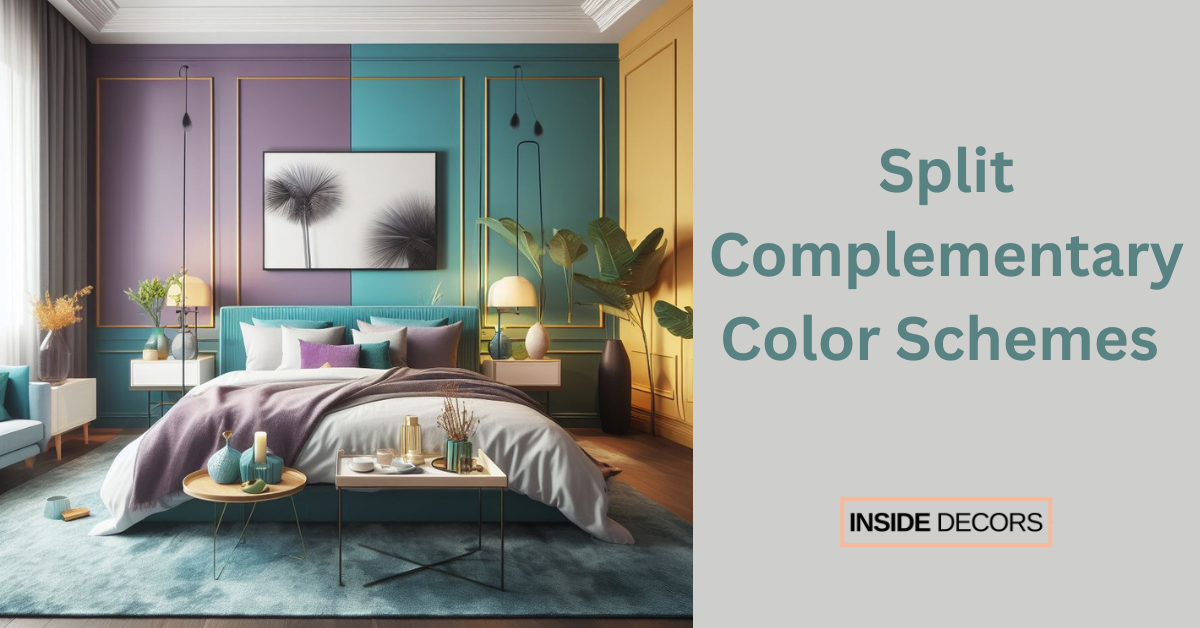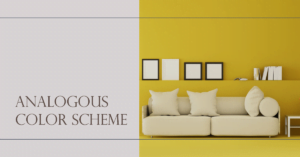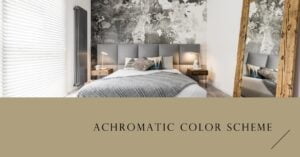Welcome to our comprehensive guide on mastering split complementary color schemes in interior design.
If you’ve ever wondered how to create a visually stunning space that balances contrast and harmony, you’re in the right place.
In this comprehensive guide, we’ll look at split complementary colors, a concept that might sound complex but is a fantastic tool for creating beautiful and balanced interior designs.
We’ll explore what split complementary colors are, how to identify them on the color wheel, and how they can transform your space.
Whether you’re a seasoned interior designer, an aspiring decorator, or a homeowner looking to spruce up your space, understanding color schemes, particularly split complementary ones, is a game-changer.
We’ll provide real-life examples, practical tips, and common mistakes to avoid. Plus, we’ll answer some frequently asked questions about split complementary color schemes.
By the end of this article, you’ll be equipped with the knowledge and inspiration to create visually pleasing spaces that strike the perfect balance of contrast and harmony.
Understanding Split Complementary Color Scheme
I’ve always been fascinated by the power of color.
It’s one of the most transformative elements in a room, capable of setting the mood, influencing our emotions, and even altering our perception of space.
One of the most intriguing, yet often misunderstood, concepts in color theory is the split complementary color scheme.
Definition and Basics of Split Complementary Colors
A split complementary color scheme is a little twist on the traditional complementary color scheme we all know.
Instead of using two colors directly opposite each other on the color wheel, a split complementary scheme involves one base color and the two colors adjacent to its direct complement.
For instance, if you choose blue as your base color, instead of pairing it with its complement, orange, you would pair it with the colors adjacent to orange – let’s say, yellow-orange and red-orange.
This gives you the contrast of the complementary scheme but with a softer, more harmonious feel.
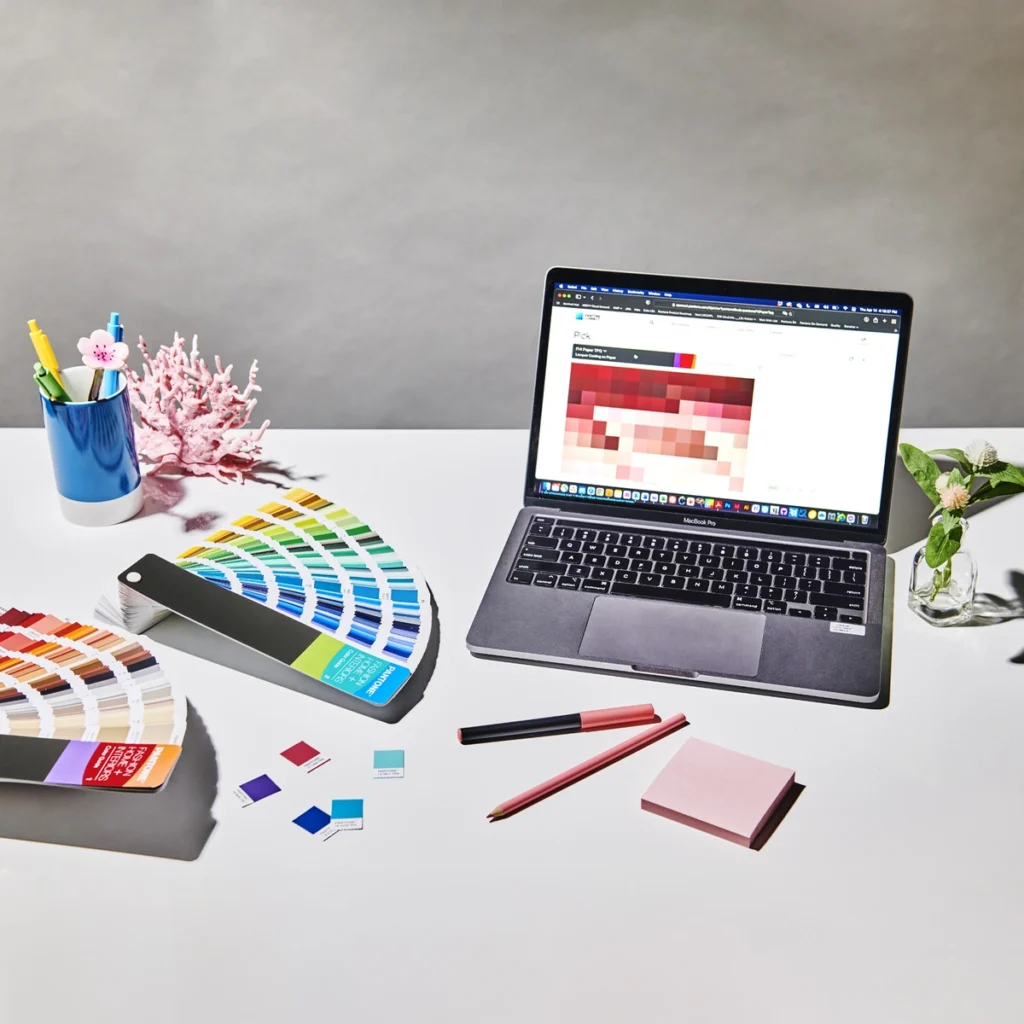
AVAILBE HERE!
The Role of Contrast in Split Complementary Color Scheme
Contrast plays a crucial role in a split complementary color scheme. It’s what makes this scheme visually exciting and dynamic.
The base color creates a strong visual contrast with the adjacent colors of its complement, adding depth and dimension to the space.
However, because the two secondary colors are close to each other on the color wheel, they also share a certain harmony.
This balance between contrast and harmony is the beauty of a split complementary color scheme. It offers a vibrant, lively look without being too jarring or overwhelming.
In the world of interior design, understanding and applying split complementary color schemes can open up a whole new realm of possibilities.
It’s a tool that allows us to play with color, create interest, and bring our spaces to life in a unique and captivating way.
The Color Wheel and Split Complementary Colors
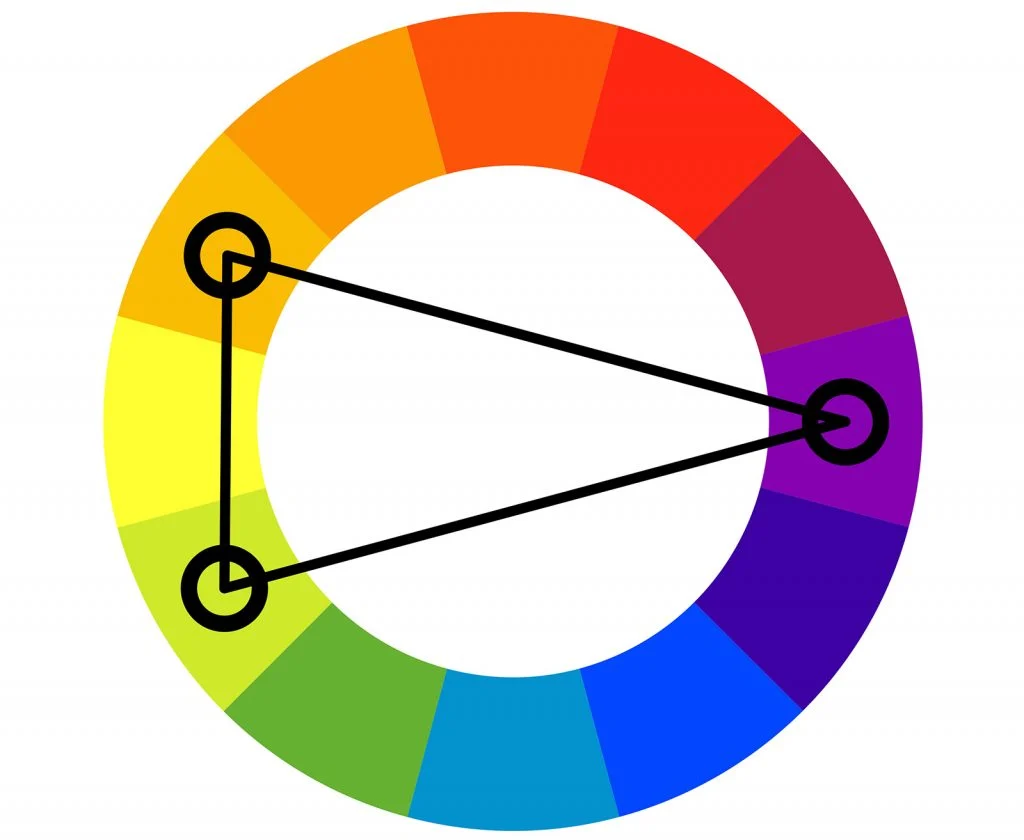
The color wheel is our trusted guide in the world of color theory. It’s a circular diagram of colors arranged by their chromatic relationship.
It’s where we can visually understand the concept of primary, secondary, and tertiary colors and how they relate to each other. But more importantly, it’s our road map to creating successful color schemes, including the split complementary scheme.
Identifying Split Complementary Colors on the Color Wheel
To identify split complementary colors on the color wheel, start by choosing a base color. This could be any color on the wheel that catches your eye or fits your design vision.
Once you’ve chosen your base color, find its direct complement, the color directly opposite it on the wheel.
Here’s where the ‘split’ in split complementary comes in. Instead of using the direct complement, you’re going to use the two colors on either side of it.
These two colors, along with your base color, form your split complementary color scheme.
For example, if you choose blue as your base color, its direct complement on the color wheel is orange. The colors on either side of orange could be yellow-orange and red-orange. So, your split complementary scheme would be blue, yellow-orange, and red-orange.
The Role of Primary and Secondary Colors
Understanding the role of primary and secondary colors is key to mastering split complementary color schemes.
Primary colors – red, blue, and yellow – are the building blocks of all other colors. When you mix two primary colors, you get secondary colors – green, orange, and purple.
In a split complementary color scheme, your base color can be a primary or secondary color.
The two colors you pair with it will typically be a mix of primary and secondary colors. This combination allows for a rich contrast while maintaining a sense of harmony and balance in your design.
Remember, the color wheel is more than just a tool for identifying split complementary colors. It’s a source of inspiration, a way to visualize relationships between colors, and a guide to creating color schemes that bring beauty, balance, and personality to your spaces.
Examples of Split Complementary Color Schemes in Interiors
Seeing is believing, isn’t it? Let’s take a look at some examples of split complementary color schemes in real-life interiors.
These examples will help illustrate how this color scheme can be applied to create visually appealing and harmonious spaces.
Residential Interior Examples: Split Complementary Room Designs
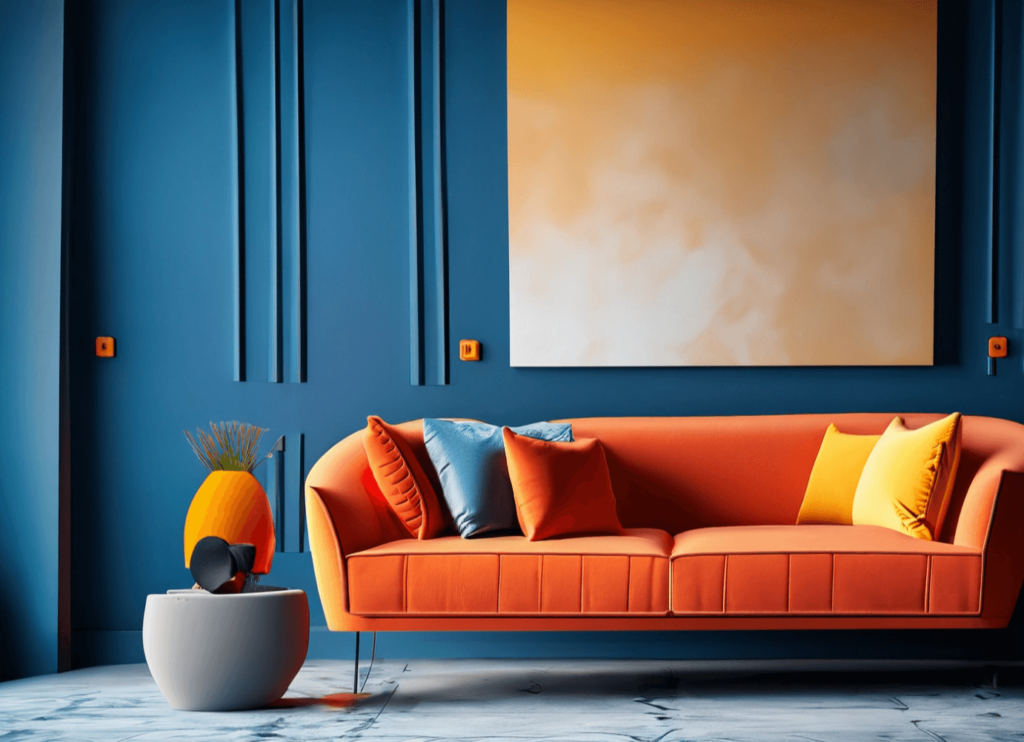
Imagine walking into a living room where the main color is a rich, deep blue.
The furniture is upholstered in shades of red-orange and yellow-orange, creating a vibrant contrast with the blue walls.
The overall effect is dynamic and engaging, yet harmonious. This is the magic of a split complementary color scheme.
In a bedroom, consider soft lavender as the base color. Paired with accents in yellow-green and yellow-orange, such as throw pillows, rugs, or artwork, it creates a serene yet visually interesting space.
The cool lavender contrasts beautifully with the warmth of the yellow tones, creating a balanced and inviting room.
Commercial Interior Examples: Split Complementary Colors in Action

In commercial spaces, split complementary color schemes can create a memorable impression.
Picture a trendy cafe with sage-green walls. The chairs are soft pink, and the light fixtures and accents are a vibrant orange.
The result is a space that’s both energetic and harmonious, a perfect backdrop for lively conversations and delicious coffee.
Or imagine a boutique with bold red as the base color. Accents in green-yellow and green-blue, in the form of display units, signage, and decor, create a striking contrast that’s sure to catch the eye of passersby.
These examples illustrate how split complementary color schemes can be used in various settings to create unique, visually appealing interiors.
Whether you’re designing a home or a commercial space, this color scheme offers endless possibilities for creativity and individual expression.
How to Use a Split Complementary Color Scheme in Your Design
Now that we’ve explored what a split complementary color scheme is and seen some examples, let’s talk about how you can use this color scheme in your own designs.
Whether you’re designing a room in your home or a commercial space, these tips will help you use a split complementary color scheme effectively.
Choosing Your Base Color and Complementary Color Pairs
The first step in creating a split complementary color scheme is choosing your base color.
This is the dominant color in your design and the one that will set the overall mood of your space.
It could be a color you love, a color that suits the function of the room, or a color that complements the existing furniture or architectural features of the space.
Once you’ve chosen your base color, identify its direct complement on the color wheel. Then, instead of using this complement, choose the two colors on either side of it. These will be your complementary color pair.
Remember, the goal is to create a balance of contrast and harmony. So, while your base color should be the dominant color, your complementary colors should be used in smaller quantities to create accents and highlights.
Balancing Your Split Complementary Colors in the Space
When using a split complementary color scheme, it’s important to balance the colors in your space.
This doesn’t necessarily mean using all colors equally. Instead, it means using them in a way that creates a harmonious and visually pleasing effect.
A good rule of thumb is to use your base color for about 60% of the room. This could be on the walls, floors, or large pieces of furniture.
Then, use one of your complementary colors for about 30% of the room. This could be in the form of upholstery, curtains, or rugs.
The remaining 10% can be your second complementary color, used for accents and accessories like cushions, lamps, or artwork.
This is called the 60 -30-10 rule you can read more here on this.
Remember, these are just guidelines. Feel free to play around with these proportions to create a look that suits your personal style and the specific needs of your space.
Using a split complementary color scheme can be a fun and rewarding way to bring color into your designs. With a bit of knowledge and creativity, you can create spaces that are vibrant, balanced, and uniquely yours.
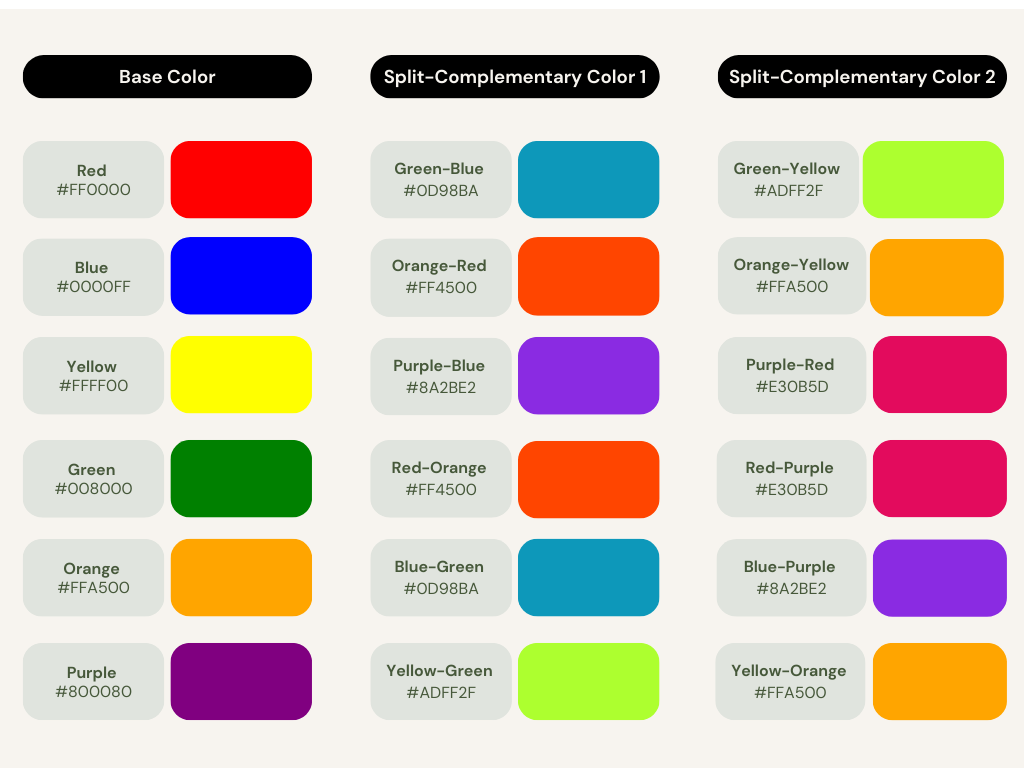
Benefits of Using Split Complementary Color Schemes
Split complementary color schemes are a favorite among designers for a reason. They offer a unique blend of contrast and harmony, creating spaces that are vibrant yet balanced. But the benefits don’t stop there. Here are a few key advantages of using split complementary color schemes in your interior designs.
Visual Interest and Balance in Split Complementary Color Scheme
One of the main benefits of a split complementary color scheme is the visual interest it creates.
By using three different colors, you’re able to add depth and dimension to your space. The contrast between the base color and its split complements catches the eye and adds a dynamic element to the room.
At the same time, because the two complementary colors are adjacent on the color wheel, they share a certain harmony. This ensures that, despite the contrast, the overall look is balanced and pleasing to the eye.
It’s this unique combination of contrast and harmony that makes split complementary color schemes so appealing.
Versatility of Split Complementary Color Schemes in Interior Design
Another benefit of split complementary color schemes is their versatility.
They can work in a variety of spaces, from residential to commercial, and from minimalist to maximalist styles.
Whether you’re designing a cozy living room, a vibrant café, or a professional office space, a split complementary color scheme can be adapted to suit the mood and function of the space.
Furthermore, because you’re working with three colors instead of two, you have more options for mixing and matching. This allows you to create a design that’s unique and personalized, reflecting your individual style or the brand identity of a business.
Using a split complementary color scheme in your designs can offer many benefits. From creating visual interest and balance to offering versatility and room for creativity, it’s a tool that can help you create spaces that are both beautiful and functional.
Common Mistakes to Avoid When Using Split Complementary Colors
While split complementary color schemes can create stunning results, there are a few common pitfalls to avoid. As with any design tool, it’s important to use it thoughtfully and with a clear understanding of its principles. Here are some common mistakes to watch out for when using split complementary colors in your designs.
Overwhelming Use of Colors in Split Complementary Color Scheme
One of the most common mistakes is using too much of each color, which can result in a chaotic and overwhelming look.
Remember, balance is key in a split complementary color scheme.
A good rule of thumb is to use your base color for about 60% of the room, one of your complementary colors for about 30%, and the other complementary color for the remaining 10%. This will ensure a balanced and harmonious look.
Neglecting Neutrals in Split Complementary Color Scheme
Another common mistake is neglecting neutrals.
While a split complementary color scheme involves three colors, it’s important not to forget about neutrals like white, black, grey, and beige.
Neutrals can help to balance the vibrant colors in your scheme and provide a calming backdrop against which your colors can shine.
Consider using neutrals for elements like walls, floors, or large pieces of furniture. Also incorporating an achromatic color scheme can do wonders.
Ignoring the Room’s Function and Lighting
Finally, it’s important to consider the function of the room and the lighting conditions.
Different colors can evoke different moods and responses, so choose a base color that suits the mood you want to create.
For example, a bedroom might benefit from a calming blue, while a home office might be energized by a vibrant yellow.
Similarly, consider the lighting in the room. Colors can look very different under different lighting conditions, so always check your color choices under the lighting conditions of the room.
Avoiding these common mistakes will help you to use split complementary color schemes effectively in your designs. With a bit of care and consideration, you can create spaces that are vibrant, balanced, and beautifully harmonious.
The Psychology of Split Complementary Colors
Color is more than just a visual element. It has the power to evoke emotions, influence our mood, and even affect our behavior.
This is where the psychology of color comes into play. Understanding the psychological effects of colors can help us make more informed design decisions.
Let’s explore the psychology of split complementary colors and how they can impact the feel of a space.
Emotional Responses to Split Complementary Colors
Every color evokes a different emotional response. For example, red is often associated with energy and passion, while blue can evoke feelings of calm and tranquility.
In a split complementary color scheme, the combination of three colors can create a complex and nuanced emotional landscape.
The base color sets the overall mood of the space.
The two complementary colors, by providing contrast, add depth and complexity to this mood.
For instance, a room with a blue base color and orange-yellow and red-orange accents can feel both calming (due to the blue) and energizing (due to the warm accents).
Color Psychology in Interior Design: The Impact of Split Complementary Colors
In interior design, understanding color psychology can help us create spaces that not only look good but also feel good.
A split complementary color scheme, with its balance of harmony and contrast, can create a dynamic and engaging atmosphere.
The harmony between the two complementary colors can create a sense of balance and stability, making the space feel comfortable and inviting.
The contrast with the base color adds an element of excitement and vitality, keeping the space from feeling too predictable or boring.
The psychology of split complementary colors is a fascinating aspect of color theory that can add depth and richness to your designs.
By understanding the emotional responses that different colors can evoke, you can use a split complementary color scheme to create spaces that are not only visually appealing but also emotionally resonant.
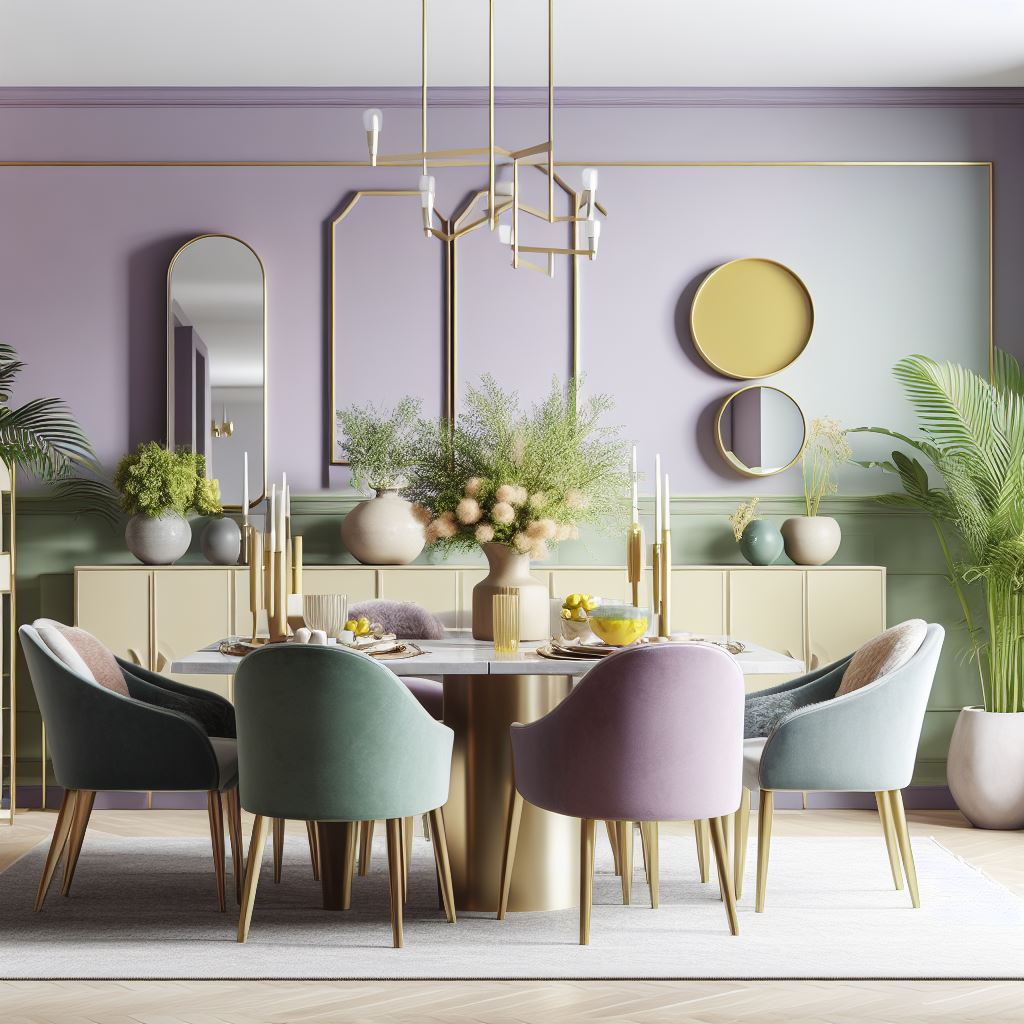
Comparing Split Complementary with Other Color Schemes
Every color scheme has its own unique characteristics and effects, and understanding these can help you choose the right scheme for your design project.
Let’s compare split complementary color schemes with some other popular color schemes: complementary, analogous, and triadic.
Split Complementary vs. Complementary Color Schemes
A complementary color scheme uses two colors that are directly opposite each other on the color wheel, such as blue and orange or red and green.
This scheme offers high contrast, creating a vibrant and dynamic look. However, it can also be quite intense and needs to be balanced carefully to avoid clashing.
On the other hand, a split-complementary color scheme uses a base color and the two colors adjacent to its complement.
This scheme still offers contrast, but it’s less intense than a complementary scheme, resulting in a more harmonious and balanced look.
Split Complementary vs. Analogous and Triadic Color Schemes
An analogous color scheme uses colors that are next to each other on the color wheel, such as blue, blue-green, and green.
This scheme is very harmonious and calming, but it lacks the contrast and dynamism of a split complementary scheme.
A triadic color scheme uses three colors that are evenly spaced around the color wheel, such as red, yellow, and blue.
This scheme is vibrant and balanced, but it can be quite bold and needs to be used carefully to avoid overwhelming the space.
In comparison, a split complementary scheme offers a unique balance of contrast and harmony.
It’s less intense than a complementary or triadic scheme but more dynamic than an analogous scheme, making it a versatile and appealing choice for many design projects.
While each color scheme has its own strengths and effects, a split-complementary color scheme offers a unique combination of contrast and harmony that can create visually appealing and balanced designs.
Choosing the Right Colors for Your Space
Choosing the right colors for your space is a crucial step in any design project. The colors you choose can influence the mood, perception, and functionality of the space.
When working with a split-complementary color scheme, there are a few key factors to consider.
Considering Room Function and Size in Split Complementary Color Scheme
The function of the room should be a major factor in your color choice.
For instance, a bedroom might benefit from calming colors like blues or greens, while a home office might need energizing colors like yellows or oranges.
The size of the room is another important consideration. Light colors can make a small room feel larger and more open, while dark colors can make a large room feel cozier and more intimate.
The Impact of Lighting on Split Complementary Colors
Lighting can significantly impact how colors appear.
Natural light will show the truest color, while incandescent lighting can bring out warm tones, and fluorescent lighting can enhance cool tones.
When choosing your colors, consider the lighting conditions in the room. You might want to test your colors at different times of the day and under different lighting conditions to see how they look.
Choosing the right colors for your space involves considering the function and size of the room, as well as the lighting conditions.
With these factors in mind, you can choose a split complementary color scheme that enhances the beauty and functionality of your space.
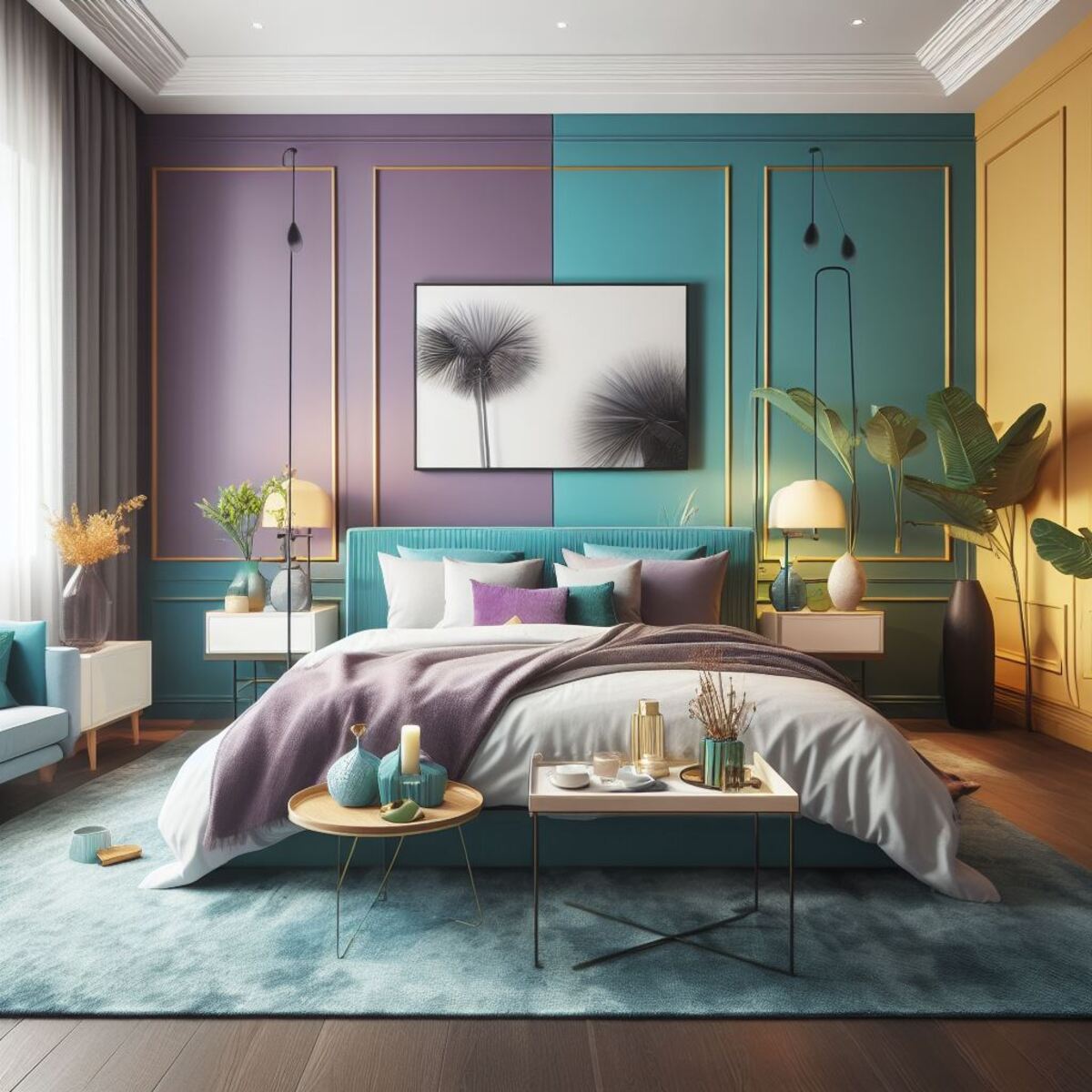
Incorporating Patterns and Textures in Split Complementary Color Scheme
While color is a crucial element in interior design, it’s not the only one.
Patterns and textures can add depth, interest, and personality to your space. When combined with a split complementary color scheme, they can create a truly dynamic and engaging design.
Using Patterns in Split Complementary Color Scheme
Patterns can be a great way to incorporate your split complementary colors.
For instance, a rug or a set of cushions in a geometric pattern that includes your base color and its split complements can tie the room together and reinforce your color scheme.
When using patterns, consider the scale and complexity of the pattern.
Large-scale, complex patterns can be quite bold and may compete with the vibrant colors in a split complementary scheme. On the other hand, small-scale, simple patterns can add interest without overwhelming the space.
The Role of Textures in Split Complementary Color Scheme
Textures, like patterns, can add depth and interest to your design. They can also influence how we perceive colors.
For instance, a rough texture can make a color seem darker, while a smooth texture can make it seem lighter.
In a split complementary color scheme, consider using different textures for each color. This can help to differentiate the colors and add an extra layer of depth to your design.
For example, you might choose a soft, plush fabric in your base color, a smooth, glossy material in one of your complementary colors, and a rough, natural texture in the other.
Incorporating patterns and textures into your split complementary color scheme can create a rich, layered, and visually interesting design.
By considering the scale and complexity of patterns and the type and feel of textures, you can enhance the impact of your color scheme and create a truly engaging space.
Case Study: Successful Split Complementary Interior Designs
Real-world examples can provide valuable insights into how split complementary color schemes work in practice.
Let’s take a look at a couple of case studies where these color schemes have been successfully implemented in interior designs.
Case Study 1: Vibrant Living Room Design
Our first case study involves a living room design where the designer chose a bold red as the base color. The split complements chosen were green-blue and green-yellow.
The red was used on the walls, creating a warm and energetic backdrop for the room. The green-blue was incorporated into the upholstery of the sofa and armchairs, providing a cool contrast to the red. The green-yellow was used sparingly in accessories like cushions and vases, adding a touch of brightness and freshness to the room.
The result was a vibrant and dynamic living room that was also balanced and inviting. The split complementary color scheme allowed the designer to create a strong visual impact while maintaining harmony and cohesion in the room.
Case Study 2: Calming Bedroom Design
Our second case study is a bedroom design where the designer chose a calming blue as the base color. The split complements were orange-red and orange-yellow.
The blue was used on the walls and bed linens, creating a serene and restful atmosphere. The orange-red was incorporated through a rug and throw pillows, adding warmth and contrast to the cool blue. The orange-yellow was used in small accents like a bedside lamp and artwork, adding a touch of brightness and energy to the room.
The result was a bedroom that was both calming and visually interesting. The split complementary color scheme allowed the designer to create a space that was harmonious yet dynamic, perfect for relaxation and rejuvenation.
These case studies illustrate how split complementary color schemes can be used effectively in interior design. They show that with careful color selection and thoughtful application, this color scheme can create spaces that are vibrant, balanced, and visually appealing.
Follow us on Pinterest
FAQ
How to draw a split complementary color scheme?
Choose a base color on the color wheel. Find its direct complement, then select the two colors on either side of it. These three colors form your split complementary scheme.
What is the split complementary color scheme?
A split complementary color scheme involves one base color and the two colors adjacent to its direct complement on the color wheel. It offers a balance of contrast and harmony.
What is color split complementary color scheme definition?
A split complementary color scheme involves one base color and the two colors adjacent to its direct complement on the color wheel. It offers a balance of contrast and harmony.
What is a split complementary color scheme?
It’s a color scheme that uses a base color and the two colors next to its direct complement on the color wheel. It’s less intense than a complementary scheme but more dynamic than an analogous scheme.
What is a split complementary color scheme? and give an example.
A split complementary scheme involves a base color and two colors adjacent to its complement. For example, blue with yellow-orange and red-orange.
What is the difference between a complementary and a split complementary color scheme?
A complementary scheme uses two colors directly opposite each other on the color wheel, while a split complementary scheme uses a base color and the two colors adjacent to its direct complement.
What would be the third color in a split complementary scheme with red-purple and red-orange?
The third color in this split complementary scheme would be yellow-green, which is the color directly across from red-purple on the color wheel.
What is an example of a split complementary color scheme?
An example of a split complementary color scheme could be blue (base color) with yellow-orange and red-orange (split complements).
What is split complementary color scheme?
A split complementary color scheme involves one base color and the two colors adjacent to its direct complement on the color wheel. It provides a balance of contrast and harmony.
How can I use a split complementary color scheme in my home?
Start by choosing a dominant base color for the walls or large furniture. Then, use the two split complementary colors for accents like cushions, rugs, or wall art to create balance and contrast.
Is a split complementary color scheme suitable for any room?
Yes, a split complementary color scheme is versatile and can work in any room, from a calming bedroom to a vibrant living room. The key is to balance the colors effectively.
Can I use patterns and textures in a split complementary color scheme?
Absolutely! Patterns and textures can add depth and interest to your design. Just ensure they complement your color scheme and don’t overwhelm the space.

